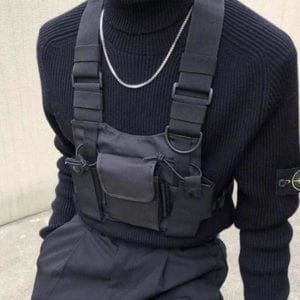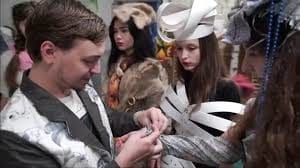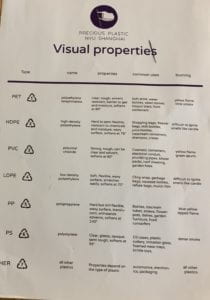Name: Eva Solo
Date: 16/10/19
Professor: Marcela Godoy
As I narrowed down the concept for the wearable being the ultimate protection shield of our generation, a bullet proof / stab proof vest, I needed to gather information on the product as it exists on the market right now and see how I can adapt and interpret it further to develop my message.
- Aesthetics Inspiration:
The Real Deal:
The bulletproof vest is designed to to protect vital organs by its design layout for the body [ — potentially designing it to protect the ‘heart’ as a focal point, as I associate the Earth being the centre of all of our lives, the heart of it all, and this vest would be a metaphorical garment for the Earth — more development on this idea later ].
What raw materials are used? http://www.madehow.com/Volume-1/Bulletproof-Vest.html
“composed of many layers of either Kevlar, Spectra Shield, or, in other countries, Twaron (similar to Kevlar) or Bynema (similar to Spectra)” “in fabric shell that is usually made from a polyester/cotton blend or nylon” “by sewing a sheet of some absorbent material such as Kumax onto it” “nylon padding for extra protection” “built-in pouches are provided to hold plates made from either metal or ceramic bonded to fibreglass” “the sides are connected with elastic webbing” “they are secured with straps of either cloth or elastic, with metallic buckles or velcro closures”
^With this information, I will be able to replace the materials used for the actual product with substitutes of my own interpretation. As I am using this as a primary inspiration, I would like to relate back to this list as much as I can when picking out from my raw trash collection.
Fashion Interpretations:
From the media I consume, I am pretty familiar with rappers and other public figures using this design to either express their stance or send a message of their tough home environments. I have also seen this design further adapted as a fashion wearable of a bag.
I am also aware of some fashion brands using this as an aesthetic for their runway shows.
Some considerations: When using this aesthetic, are they trying to emphasise their that they are invincible? Or are they highlighting their fear? Their weak fragile bodies? When fashion brands convey this message through their apparel, are they further highlighting the importance of protection? Or the unbelievably chaotic reality of our current society?
- Artist Inspiration:
Artur Brazhe is a Russian eco-friendly designer who upscales raw materials into beautiful designs. He was a great source of inspiration for the development stage of my project, as I was able to further read about his stance on the importance of being ecologically aware.
In preparation for his projects, he specifically looks for discarded materials in trash-fills that are the most damaging to the environment. In most cases he seeks to find plastics and aluminium as well as plastic coated paper. In relation to his country, he seeks to spread the message of considering before you buy and then toss – thus entering his pieces in high-fashion competitions – surprisingly his contributions were even acknowledged by the government (which in Russia is a big deal due to a very minimal communication of the residence and the higher -ups). He stands as inspiration to me, when I think of my own home and how unaware everyone from the locals to the authorities truly are on consumption and its damages. I have recently visited a trash-fill outside the capital of Vilnius, that time I only drove by it, but I am definitely going to check it out up close next time I am at home.
- Material Research:
We have been exploring the properties of plastics in the recent weeks. I learned about the categorisation of different plastics – truthfully speaking I had assumed there was only one chemical combination that made up ‘plastic’ and that it was changed to altered the physical state.
To learn that we produce such variations of plastic that cannot even be attempted to be recycled was very shocking. I immediately started thinking of the larger picture in question: Why are we STILL producing all of this terrible material with no way out from our planet? Can we ship it to space? Can we use the funds collected from damaging the environment and put it towards technologies that could manage these materials? Can we look into designing a safe alternative? Safer at least?
I was able to obtain some of the posters our school prints that are made from flexible/fabric-like plastic and connected with thin thread. I have noticed these around our building before, but I had assumed we at least reuse them… Talking to Lucky from Student Life: I learned that these are periodically printed for short term usage and then immediately discarded. To my understanding we do not utilise this poster material for anything else. I collected a few of these to upscale and give them more value. The second stage of my scavenge hunt included looking for cardboard, which was not difficult seeing around 4-8 card-boarded/bubble wrapped / and plastic safeguarded packages being delivered to my apartment on a weakly basis. I also needed some detailing of metal, for which I collected aluminium cans and copper wire. Lastly I knew I wanted to add some aesthetic elements of paint or decorations – and for this step I did not want to ignore the fact that we are giving materials a second-life, so I took a mind-note to utilise left overs from my next art project (which I always wash left over paints, and discard cut outs to the trash bin).
Aside from collecting otherwise useless materials and upscaling them for my design, I considered how we use plastic for the protection of our bodies in the protection vests, yet use that same material to ultimately push our precious Earth to its death bed. The irony of this consideration motivated me to create a piece that draws the eyes of the audience by its bold aesthetic and hopefully provokes some questions or further discussions.
- Techniques I want to explore:
This week I learned to use the sewing machine!!! I had always wanted to experiment with this technology but never had the chance to participate in a tutorial, and the previous self attempts were slightly discouraging.
I learned the proper way to set up the machine and insert the thread correctly following the 1-2-3-4-5 step map. The tension setting was still slightly confusing but I managed to create a few straight lines on the testing fabric and could not be more thrilled. I managed to relax and keep a steady hand on my fabric, as the machine can be a little bit intimidating with the rapidly moving needle.
I also played around with different patterns ( now I know the tension should have been adjusted to get the designs I wanted!) but never the less, the process was very rewarding.
I want to further explore the sewing machine and use it for connections as well as design development.




















Leave a Reply